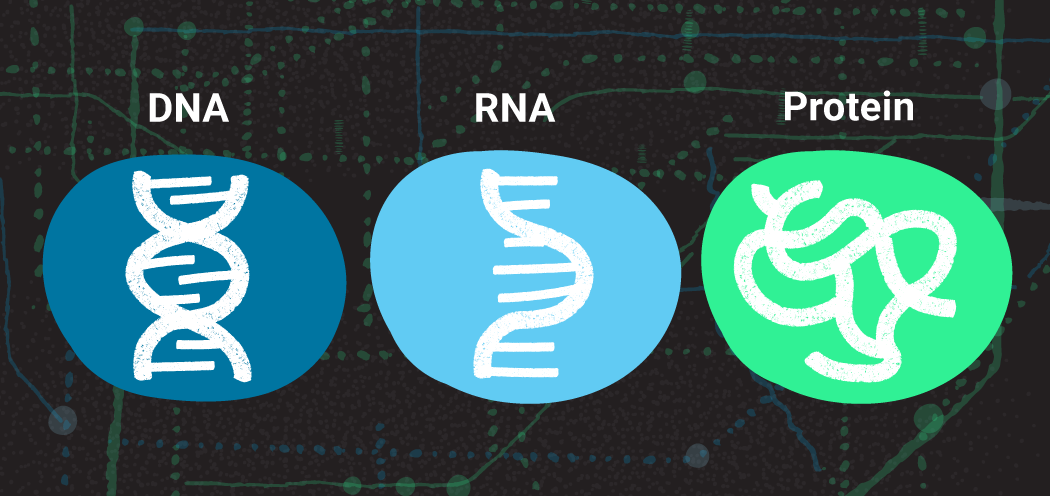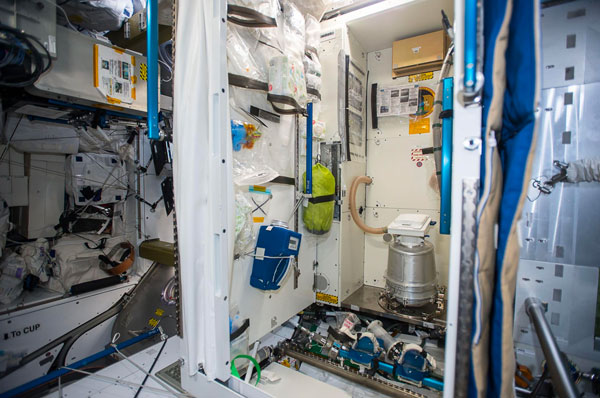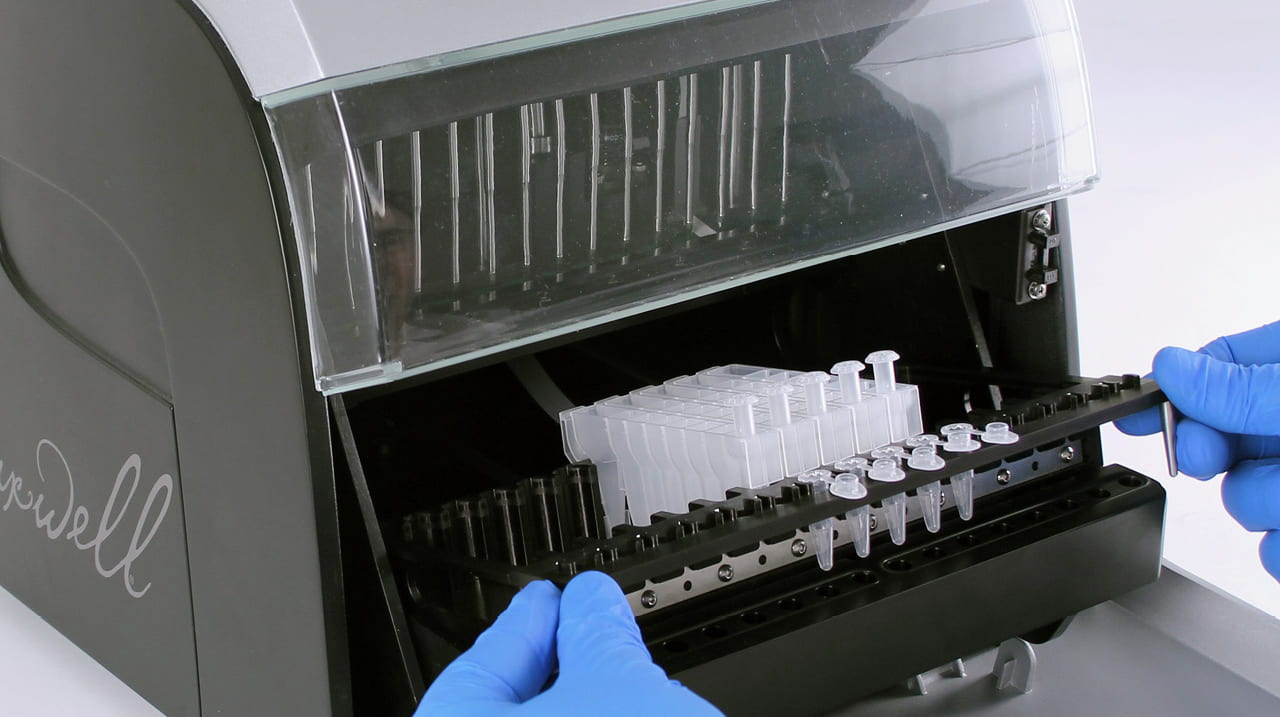Metagenomics, Microbes and the Meaning of Life
From subways to space stations and beyond
By Mariel Mohns
When Christopher Mason speaks, his enthusiasm commands your attention. He talks with an excitable rhythm, and he doesn’t skip a beat when he makes a sly joke—a personality that seems fit for the hustle and bustle of New York City life. Mason is just one of the millions of New Yorkers who ride the subway on a daily basis. Like the dynamic molecular processes of biology, the mass transit system of NYC is constantly in motion. And each commuter also carries onboard the trillions of bacteria in their microbiome as unseen passengers. Of course, microbiome studies show that our microscopic passengers are mostly harmless, and even helpful. Yet there is still much that is unknown about the microbial world around us. Researchers like Mason are driven by an infectious curiosity to understand the “why” and the “how.”

Over 5 million people ride the NYC subway every day.
Photograph by Felix Lipov ©123RF.com
At a macroscopic level, his mission is to explore our world—and ultimately the universe beyond. At the microscopic level, he’s using genomics to make new discoveries about the microbiome in us and around us, to better understand the influence and impact of what it means to be human.
Beyond the Central Dogma
Mason—an associate professor at Weill Cornell Medicine—is one of the global leaders in the growing field of metagenomics. As technology advances, scientists can collect and analyze larger biological datasets that provide a more powerful approach to solving biomedical problems. The central dogma of biology describes the flow of biological genetic information collectively known as the genome. DNA is transcribed into RNA, which is then translated into proteins—the molecular fields of genomics, transcriptomics and proteomics, respectively. But the large datasets of “-omics” research shows us that biology isn’t simple. Between each transition, there are chemical modifications and edits that influence the functionality of these biological building blocks. When you start to think about the scope of all these variations, the field of study expands beyond just the genome and becomes the epigenome; and likewise, the epitranscriptome and epiproteome. The world of metagenomics takes this idea even further. “In a nutshell, metagenomics is when you include all the DNA of all species,” says Mason, “Really anything you sequence in a sample—whether it’s clinical, environmental, or otherwise.” By looking at the presence of all biological genomes present in a sample, it creates a snapshot or signature of biological information at a given point in time.

Metagenomics has transformed the way researchers and clinicians approach health and medicine. The completion of the Human Genome Project in 2003 provided the baseline for understanding complex human diseases that are genetically inherited. Advances in sequencing technology allow researchers to piece together millions of DNA fragments and map it to the human genome reference sequence. This technological breakthrough offers another method of detecting, diagnosing and treating disease. As the field of microbiome research grows, metagenomic sequencing opens the door to learn more about the genetic relationship of infectious disease, antimicrobial resistance and immunity. With the ability to sequence the metagenome, scientists can unravel the mysteries of not only human health and disease, but also explore how humans interact with the outside world.
The Curiosity of a Child
The pursuit of scientific knowledge is driven by our natural curiosity, a fundamental human trait that is probably most exemplified by toddlers. They’re young enough to not know everything, and yet mature enough to have personal agency—leading to the often-unfiltered expression of their own thoughts and actions. Mason recalls one day that he was riding the subway with his daughter, when she spontaneously bent over and licked a pole on the subway. His immediate reaction was shock. “I had a moment of parental terror. I’m wondering ‘what just transpired?’” But like his daughter—and like any good scientist—his curiosity got the best of him.
“Clearly there was a microbiome transfer, so I went home and tried to figure out what is known about what’s on the surfaces of mass transit systems,” he says. He found only a handful papers that examined the microbiome of air samples using 16S sequencing, a quick method of detecting and identifying different species of bacteria (1,2). Not much was known. So, Mason and his team started swabbing various surfaces of the New York City to create a “genetic map” of the microbiome, not of individual people, but of the city itself.
"In a world where you don't know what to look for, the best thing to do is explore."
Today, Mason’s project has expanded into a global-scale project called MetaSUB. Researchers from across the world are using metagenomics to swab and sequence DNA from built environments to understand the “genetic cartography” of Earth’s major cities. At such a large scale, the MetaSUB project requires eager participants, efficient methods, and reliable technologies. Mason and his colleagues coordinate a Global Sampling Day, using citizen scientists that participate around the globe. On the same day, at the same time, individuals are instructed to use the same protocol. They swab everything around the city: turnstiles, kiosks, benches, and more. Each swab is barcoded and scanned into a customized mobile app designed for the project.
Once the samples have been collected, the teams need to extract DNA. When working with large data sets, the quality of the samples, the extraction methods and instrument sensitivity can all influence data analysis. Mason's team uses Maxwell® Instruments for most of the DNA extraction and then perform next-generation sequencing on the Illumina platform, or long-read platforms like Oxford Nanopore.
“Automation is key, because you want to reduce any batch effects or problematic areas of technician error,” he says. Additionally, when extracting DNA from samples of unknown material from unique sources, low input is a concern when a high yield is desired. “[Maxwell] actually solved all those problems for us. It was great.” He estimates that they have collectively extracted DNA from about 10,000 samples and have sequenced about half of them. The plan is to continue sampling through 2020, and get about 30,000 samples total.
The project has three major goals: 1) Discover what is around us; 2) Track antimicrobial resistant markers; and 3) Scan for new biosynthetic gene clusters. “In a world where you don’t know what to look for, the best thing to do is explore,” says Mason. As it happens in science, the unknown often leads to more unknowns, driving the scientific method of inquiry. In the inaugural New York City study, Mason and his team discovered many new fragments of DNA that had never been seen before. In any given sample, almost 50% of the DNA did not match any previously known organism, human or otherwise (3). Additionally, collected data provides a dynamic overview of antimicrobial resistant markers and biosynthetic gene clusters. Different “hotspots” appear in different cities. Mason believes that this data will aid the development of new antibiotics or other molecular drug compounds that reduce the risks of disease transmission or bioterrorism. He doesn’t interpret these findings through fear, but through hope that they will inform better decisions about public health and preserving humanity.
To Orbit and Beyond
Discovery efforts don’t stop in our home cities—or our home planet. Mason’s next mission is bringing his curiosity into outer space and beyond. “I went to space camp as a kid, so I’ve always been interested in space,” says Mason. Given the chance to combine his love of space with his love of genetics, he was ready to explore more of the unknown.
The International Space Station (ISS) is a collaborative project that launched into orbit in 1998. It serves as a research environment for a variety of science fields, collecting data on the effects of zero gravity and exposure to space. It has been continuously occupied by a crew of up to six researchers since November 2000, with visits from over 200 people from 18 different countries. While most missions last between 4–6 months, astronauts Scott and Mark Kelly, identical twins, became the subjects of the NASA Twins Study, a year-long mission to study the effects of space on the human body. Scott Kelly commanded the ISS as the “test subject” in orbit, while Mark Kelly remained on earth as the “control subject”.
Mason joined the project to specifically understand how human genetics might be influenced by space travel. “We wanted to get DNA, RNA and microbiome samples. We looked at everything we could, all the -omics, and profiled them,” says Mason. “It’s helped us think about getting to Mars.” As the first mission to use genomics to investigate changes in the human body, the Twins Study set the precedent for long-term space exploration. Scott Kelly spent nearly a year in space in 2015, and now nearly three years later, the results of the study have been published (4). In almost all areas of the study, collaborators reported changes in Scott Kelly’s body that were specific to spaceflight when compared to data from Mark Kelly on Earth.
"I think everyone has an innate capacity to conceive something beyond his or her own lifetime."
Mason and his team discovered that the human body is extremely resilient, but also prone to damage. “The body is extraordinarily responsive and has a lot of plasticity in terms of responding to the dangers and molecular slings and arrows of space flight,” says Mason. Six months after being back on Earth, most of Kelly’s physiology—such as cardiovascular changes, body mass or the composition of the microbiome—returned to normal. However, the less visible changes, those made at the cellular and genetic level, might be more long-term. Mason says that one major finding was the stress that space flight caused on Scott Kelly’s immune system. His immune cells showed the release of many molecules that signal inflammation. “It’s almost like the body is on high alert,” Mason says, “But it’s still functional.”
Kelly received an influenza vaccination while in orbit, and data showed that the immunization still worked and there were no significant differences in his influenza-specific T cell responses compared to those seen on Earth. Additionally, gene expression levels in almost 9% of Scott Kelly’s genes did not return to baseline levels after six months post-flight. This handful of genes include those involved with immune function and DNA repair, as well as blood clotting and bone growth. “There’s no flashing red lights, more like yellow lights—things we want to keep an eye on and measure for future missions.”
Unrelated to the Twins Study, Mason also conducted a study to explore the microbiome of the ISS itself, not unlike the NYC subway project. The astronauts took swab samples of various locations around the ISS, including crew quarters, the dining table, the foot platform of the exercise equipment, and the waste and hygiene compartment (5). Nearly 60 strains of known bacterial organisms were identified on the space station. 92% of these were resistant to penicillin, though other antibiotics were more effective.

The waste and hygiene compartment aboard the International Space Station.
Photograph by Jack Fischer / NASA
However, several strains of Enterobacter bugandensis were found to be resistant to multiple antibiotic drugs—of note, the source of these antibiotic-resistant strains was the waste and hygiene compartment. Using metagenomic analysis, Mason and his colleagues discovered that these strains were genetically similar to three clinical strains of E. bugandensis known to cause disease, and they identified several antibiotic resistant gene clusters encoded in the E. bugandensis genomes (6). Additionally, these antibiotic resistant markers were unique to the ISS strains and not found in the Enterobacter strains from Earth. Is antimicrobial resistance an effect of space travel and microgravity? What implications does this have on human health in space? These are the unknowns that curious researchers like Mason want to investigate further.
The Human Experience
All of Mason’s projects seem to lead toward something much larger and greater than any one man’s body of work. “I think everyone has an innate capacity to conceive something beyond his or her own lifetime,” says Mason. “I like humans—I think we’re good people. I think we’re the only species with an awareness of extinction and, therefore, I have the unique and innate duty to make sure that doesn’t happen.” He grapples with large philosophical and ethical questions about human survival: How would we survive on Mars, or Titan? Can the human genome be genetically modified to protect us from the extreme environment of space? How do we preserve life if the universe collapses? While it seems like science fiction, Mason believes that these hypothetical scenarios will eventually become science fact.
His research is part of what he calls a “10-phase, 500-year plan” to gain a better understanding of how to preserve humanity as we venture out into the universe. Mason wrote these long -term goals almost 10 years ago, and says that Phase 1 is nearly fully realized since advances in whole genome sequencing have made genomic discovery a possibility. Phases 2 and 3 address the use of synthetic biology and genomic engineering. “There’s a really big ethical question of how and when, or if, you should do it,” he says. This influences the work done in Phases 4 through 6, to conduct human trials for survival in space and the settlement of other planets like Mars. Phases 7 through 9 explore the ideas of expanding the human genome to survive even harsher environments, explore new Earth-like planets and inhabit these worlds. Phase 10 and beyond address human settlement on new solar systems, and the implications of continued human survival in the universe.
These big goals and concerned care for humanity are not just talk. Scaling back down to the here and now, Mason mentions how his career and the momentum of this work is only possible because of his hard-working team. He suggests that always being available and open for communication, and remaining engaged with others is the key to getting good results. And despite his busy schedule and demands of the research, Mason prioritizes family and self-care—and encourages his team to do the same. “There are a lot of things to love about life, and science is one of them, but there are many others. There’s a lot of fruit in the world to pick, taste, and enjoy.” After all, we are just small beings in the cosmic perspective—the world is only worth exploring if you have others with whom to share it.
References
- Robertson, C.E. et al. (2013) Culture-independent analysis of aerosol microbiology in a metropolitan subway system. Appl. Environ. Microbiol. 79, 3485–93.
- Leung, M.H. et al. (2014) Indoor-air microbiome in an urban subway network: diversity and dynamics. Appl. Environ. Microbiol. 80, 6760–70.
- Afshinnekoo, E. et al. (2015) Geospatial resolution of human and bacterial diversity with city-scale metagenomics. Cell Systems. 1, 72–87.
- Garrett-Bakelman, F.E. et al. (2019) The NASA Twins Study: a multi-dimensional analysis of a year-long human spaceflight. Science. 364, eaau8650.
- Urbaniak, C. et al. (2018) Detection of antimicrobial resistance genes associated with the International Space Station environmental surfaces. Scientific Reports. 8, 814.
- Singh, N.K. et al. (2018) Multi-drug resistant Enterobacter bugandensis species isolated from the International Space Station and comparative genomic analyses with human pathogenic strains. BMC Microbiology. 18,175.

